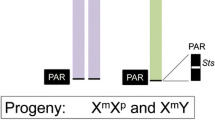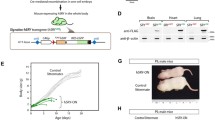Abstract
Sex determination in the mammalian embryo begins with the activation of a gene on the Y chromosome which triggers a cascade of events that lead to male development. The mechanism by which this gene, designated SRY in humans and Sry in mice (sex determining region of the Y chromosome), is activated remains unknown. Likewise, the downstream target genes for Sry remain unidentified at present. C57BL mice carrying a Y chromosome from Mus musculus musculus or molossinus develop normally as males. In contrast, C57BL/6 mice with the Y chromosome from M. m. domesticus often show sex reversal, i.e., develop as XY females. It has been documented that C57BL mice with the Y chromosome from Poschiavinus (YPOS), a domesticus subtype, always develop as females or hermaphrodites. This suggests that a C57BL gene either up- or downstream of Sry is ineffective in interacting with Sry, which then compromises the processes that lead to normal male sex development. Nonetheless, by selective breeding, we have been able to generate a sex reversal-resistant C57BL/6-congenic strain of mice in which the XYPOS individuals consistently develop as normal males with bilateral testes. Because the resistance to sex reversal was transferred from strain 129S1/Sv (nonalbino) by simple selection over 13 backcross generations, it is inferred that a single autosomal gene or chromosomal region confers resistance to the sex reversal that would otherwise result. XYPOS normal males generated in these crosses were compared to XYPOS abnormal individuals and to C57BL/6 controls for sexual phenotype, gonadal weight, serum testosterone, and major urinary protein (MUP) level. A clear correlation was found among phenotypic sex, MUP level, and testis weight in the males and in the incompletely masculinized XYPOS mice. The fully masculinized males of the congenic strain resemble C57BL/6 males in the tested parameters. DNA analysis confirmed that these males, in fact, carry the YPOS Sry gene.
Similar content being viewed by others
REFERENCES
Albrecht, K. H., and Eicher, E. M. (1997). DNA sequence analysis of the Sry alleles (subgenus Mus) implicates misregulation as the cause of C57BL/6J-YPOS sex reversal and defines the SRY functional unit. Genetics 147:1276.
Berta, P., Hawkins, J. R., Sinclair, A. H., Taylor, A., Griffiths, B. L., Goodfellow, P. N., and Fellous, M. (1990). Genetic evidence equating SRY and the testis-determining factor. Nature 348:448.
Biddle, F. G., Eisner, J. R., and Eales, B. A. (1994). The testis-determining autosomal trait, Tda-1, of C57BL/6J is determined by more than a single autosomal gene when compared with DBA/2J mice. Genome 37:296.
Bocskei, Z., Groom, C. R., Flower, D. R., Wright, C. E., Phillips, S. E., Cavaggioni, A., Findlay, J. B., and North, A. C. (1992). Pheromone binding to two rodent urinary proteins revealed by X-ray crystallography. Nature 360:186.
Bowles, J., Cooper, L., Berkman, J., and Koopman, P. (1999). Sry requires a CAG repeat domain for male sex determination in Mus musculus. Nature Genet. 22:405.
Braun, A., Kammerer, S., Cleve, H., Lohrs, U., Schwarz, H. P., and Kuhnle, U. (1993). True hermaphroditism in a 46,XY individual, caused by a postzygotic somatic point mutation in the male gonadal sex-determining locus (SRY): Molecular genetics and histological findings in a sporadic case. Am.J.Hum.Genet. 52:578.
Coward, P., Nagai, K., Chen, D., Thomas, H. D., Nagamine, C. M., and Lau, Y. F. (1994). Polymorphism of a CAG trinucleotide repeat within Sry correlates with B6. YDom sex reversal. Nature Genet. 6:245.
Eicher, E. M. (1988). Autosomal genes involved in mammalian primary sex determination. Philos. Trans.R.Soc.Lond.Biol. 322:109.
Eicher, E. M. (1994). Sex and trinucleotide repeats. Nature Genet. 6:221.
Eicher, E. M., and Washburn, L. L. (1983). Inherited sex reversal in mice: Identification of a new primary sex-determining gene. J.Exp.Zool. 228:297.
Eicher, E. M., Washburn, L. L., Whitney, J. B., III, and Morrow, K. E. (1982). Mus poschiavinus Y chromosome in the C57BL/6 murine genome causes sex reversal. Science 217:535.
Eicher, E. M., Washburn, L. L., Schork, N. J., Lee, B. K., Shown, E. P., Xu, X., Dredge, R. D., Pringle, M. J., and Page, D. C. (1996). Sex-determining genes on mouse autosomes identified by linkage analysis of C57BL/6J-YPOS sex reversal. Nature Genet. 14(2):206.
Graves, P. E., and Erickson, R. P. (1995). Sequence variation in the 59, putative promoter of Sry and its possible relevance to the C57BL/6J-YDOM sex reversal. Biochem.Biophys.Res.Commun. 208:624.
Gubbay, J., Collignon, J., Koopman, P., Capel, B., Economou, A., Munsterberg, A., Vivian, N., Goodfellow, P., and Lovell-Badge, R. (1990). A gene mapping to the sex-determining region of the mouse Y chromosome is a member of a novel family of embryonically expressed genes. Nature 346:245.
Gubbay, J., Vivian, N., Economou, A., Jackson, D., Goodfellow, P., and Lovell-Badge, R. (1992). Inverted repeat structure of the Sry locus in mice. Proc.Natl.Acad.Sci.USA 89:7953.
Harley, V. R., Jackson, D. I., Hextall, P. J., Hawkins, J. R., Berkovitz, G. D., Sockanathan, S., Lovell-Badge, R., and Goodfellow, P. N. (1992). DNA binding activity of recombinant SRY from normal males and XY females. Science 255:453.
Hawkins, J. R., Koopman, P., and Berta, P. (1991). Testis-determining factor and Y-linked sex reversal. Curr.Opin.Genet.Dev. 1:30.
Hawkins, J. R., Taylor, A., Berta, P., Levilliers, J., Van der Auwera, B., and Goodfellow, P. N. (1992). Mutational analysis of SRY: Nonsense and missense mutations in XY sex reversal. Hum. Genet. 88:471.
Houle, A. M., and Taketo, T. (1992). True hermaphrodites: An experimental model in the mouse. J.Urol. 148:672.
Keel, B. A., and Abney, T. O. (1985). Oestrogen regulation of testicular androgen production during development in the rat. J.Endocrinol. 105:211.
Knopf, J. L., Gallagher, J. F., and Held, W. A. (1983). Differential, multihormonal regulation of the mouse major urinary protein gene family in the liver. Mol.Cell.Biol. 3:2232.
Koopman, P., Gubbay, J., Vivian, N., Goodfellow, P., and Lovell-Badge, R. (1991). Male development of chromosomally female mice transgenic for Sry. Nature 351:117.
Lau, Y.-F. C., and Zhang, J. (1998). Sry interactive proteins: Implications for the mechanisms of sex determination. Cytogenet.Cell.Genet. 80:128.
Lee, C. H., and Taketo, T. (1994). Normal onset, but prolonged expression, of Sry gene in the B6.YDOM sex-reversed mouse gonad. Dev.Biol. 1654:442.
Mahadevaiah, S. K., Lovell-Badge, R., and Burgoyne, P. S. (1993). Tdy-negative XY, XXY and XYY female mice: Breeding data and synaptonemal complex analysis. J.Reprod.Fertil. 97:151.
Mannervik, M., Nibu, Y., Zhang, H., and Levine, M. (1999). Transcriptional coregulators in development. Science 284:606.
McElreavey, K., Barbaux, S., Ion, A., and Fellous, M. (1995). The genetic basis of murine and human sex determination: A review. Heredity 75:599.
Mucignat-Caretta, C., Carreta, A., and Cavaggioni, A. (1995). Acceleration of puberty onset in female mice by male urinary proteins. J.Physiol.(London) 486:517.
Mucignat-Caretta, C., Carreta, A., and Baldini, E. (1998). Protein-bound male urinary pheromones: Differential responses according to age and gender. Chem.Senses 23:67.
Myers, R. B., and Abney, T. O. (1990). Testosterone and androstanediol production by regenerating Leydig cells in the ethylene dimethane sulphonate-treated mature rat. Int.J.Androl. 13:4.
Nagamini, C. M., Taketo, T., and Koo, G. C. (1987). Morphological development of the mouse gonad in tda-1 XY sex reversal. Differentiation 33:214.
Nallaseth, F. S. (1992). Sequence instability and functional inactivation of murine Y chromosomes can occur on a specific genetic background. Mol.Biol.Evol. 9(2):331.
Palmer, S. J., and Burgoyne, P. S. (1991). The Mus musculus domesticus Tdy allele acts later than the Mus musculus musculus Tdy allele: A basis for XY sex-reversal in C57BL/6-YPOS mice. Development 113:709.
Parker, K. L., Schedl, A., and Schimmer, B. P. (1999). Gene interactions in gonadal development. Annu.Rev.Physiol. 61:417.
Sinclair, A. H., Berta, P., Palmer, M. S., Hawkins, J. R., Griffiths, B. L., Smith, M. J., Foster, J. W., Frischauf, A. M., Lovell-Badge, R., and Goodfellow, P. N. (1990). A gene from the human sex-determining region encodes a protein with homology to a conserved DNA-binding motif. Nature 346:240.
Taketo, T., Saeed, J., Nishioka, Y., and Donahoe, P. K. (1991). Delay of testicular differentiation in the B6.YDOM ovotestis demonstrated by immunocytochemical staining for mullerian inhibiting substance. Dev.Biol. 146:386.
Taketo-Hosotani, T., Nishioka, Y., Nagamine, C. M., Villalpando, I., and Merchant-Larios, H. (1989). Development and fertility of ovaries in the B6.YDOM sex-reversed female mouse. Development 107:95.
Washburn, L. L., and Eicher, E. M. (1989). Normal testis determination in the mouse depends on genetic interaction of a locus on chromosome 17 and the Y chromosome. Genetics 123:173.
Whitney, J. B., and Forrest, B. (1981). Hba: New genotypes. Mouse News Lett. 64:53.
Whitney, J. B., and Russell, E. S. (1978). Alpha thalassemia (Hba th-J). Mouse News Lett. 58:47.
Author information
Authors and Affiliations
Rights and permissions
About this article
Cite this article
Whitney, J.B., Mills, T.M., Lewis, R.W. et al. A Single Genetic Determinant that Prevents Sex Reversal in C57BL-YPOS Congenic Mice. Biochem Genet 38, 119–137 (2000). https://doi.org/10.1023/A:1001935012134
Issue Date:
DOI: https://doi.org/10.1023/A:1001935012134




